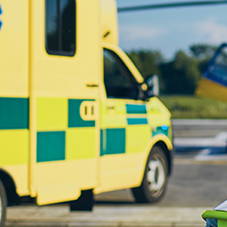A HYPOTHETICAL NEAR MISS THAT HAS A LOT TO TEACH US
The difference between going home after a day of diving or being strapped onto a hospital gurney while being prepped for several hours in a recompression chamber, can be the result of an margin of error as thin as a human hair, or a lapse of judgement as wide as the Channel Tunnel.
Perhaps related to that, a strange habit of divers, especially technical divers, is to engage in what’s called ‘accident analysis.’ This exercise may appear to be ghoulish to outsiders. An act of morbid voyeurism. But technical diving is a high-risk endeavour, and it’s better to learn from the mistakes of others rather than educating oneself firsthand. That means digging around in other people’s’ misery to find what turned a great day into a nightmare, is a necessary and useful exercise.
And that’s what this is; just a useful exercise, and nothing more.
So, let’s do a little digging. I’ve avoided using names and the location has been fudged, but what follows could easily be based on an actual event. Your job is to identify the points where things went pear-shaped. Good luck and the prize at the end is that you can avoid making the same mistakes yourself: I hope.
______________________

Accident analysis is often difficult. Unfortunately, part of the challenge when deconstructing any diving incident is it’s often difficult to unravel which of the two extremes — human hair or 45-metre-wide tunnel — was a contributing factor.
But occasionally, the answer is obvious and stands out like a nun dealing blackjack in a Las Vegas casino.
Here’s one of those ‘nun in Vegas’ scenarios.
Let’s say this incident involved two divers. Both certified instructors. One a very experienced technical instructor, but from someplace else and a stranger to local conditions. The other was a much less experienced technical instructor, but a local diver familiar with local dive sites and conditions.
The highly experienced instructor was teaching a course to the lesser experienced one. So, the dive you are being asked to deconstruct was a training dive. For the record, the course was a trimix, sidemount CCR class. A highly technical program without a doubt.
The dive was made from a boat working in an area where the prevailing current is always a factor. If you are thinking God’s Pocket, off Canada’s Vancouver Island, the Strait of Messina, between Sicily and the Italian mainland, or the Gulf Stream as it blasts along Florida’s east coast on its way to the British Isles and Northern Europe, you have the right idea. Several knots on a normal day, strong up and down welling on an extreme day. Not conditions for the faint-hearted, and always a physical and mental workout.
The subject dive was on an extreme day. During the pre-dive briefing the charter captain mentioned the current was blowing. However, our divers opted to go ahead with their planned dive to 42 metres (about 138 feet) with around 45 minutes of bottom time.
According to all reports, the dive was a challenge. The experienced technical instructor admitted afterwards it was one of his toughest dives. But he and his student put in the planned bottom time in spite of everything. It seems, that during their ascent, holding the required staged decompression stops was a challenge. Partly because of this, and because the student indicated ‘I’m tired,’ the pair added more than 10 minutes to the six-metre stop.
Back on the surface, the student showed signs of a serious, possibly neurological, DCS hit. Evacuation ensued followed by recompression and a hospital stay.
The required reports were filed and during the resulting investigation, it was discovered the student had a history of DCS and other medical challenges including a suspected PFO. However, these episodes were never mentioned in medical waivers, or pre-course conversations, or dive briefings. Nor had incident reports about them ever been submitted to the agency.
In this case, someone dodged a bullet, for sure. This was a near-miss that could easily have had a much worse outcome. But instead, it turned out to be a good learning opportunity for us all. Now, did you spot the ‘errors?’
Diving, especially technical rebreather diving, is about balance. It’s about knowing limits and working within them.
For example, most would agree a sensible starting point would be to draw boundaries around a training dive. Training dives are supposed to be controlled and somewhat protected. Not necessarily easy, but not one of the hardest dives an experienced technical instructor has made. Even when it’s a CCR course. Accordingly, a training dive is not the best platform from which to launch an all-out attack on any limits or to beat down the best practices that support ’em like fence posts.
Add to that, what for most divers even on a good day, would be challenging conditions, and the odds against a good outcome are building.
And then, opting to push limits and undertake a tough dive in unfamiliar gear (managing a sidemount rebreather and bailout bottles), adds another level of complexity.
Put all this in a blender and give it a stir, and most would consider the results a nasty concoction… something to be avoided.
And yet, all this happened.
Certainly, we could all point fingers, but what are the lessons? When and where did this all start to go wobbly?
Perhaps we can start with a little self-reflection.
As a community we have a loose approach to applying what we know is best practice to every dive we make. We get complacent. Also, too many experienced instructors allow slop when they apply the “spirit of the law” to the advice offered in course standards. Some also forget that not everyone has their experience and comfort when conditions turn tough. Of course, this attitude is ill-advised, but was that attitude a factor in this case and it is really that unusual?
Diving in marginal environmental conditions is always a dodgy choice. On this dive, opting to stay down for more than 40 minutes rather than calling the dive early was an interesting choice. Was this a factor? And again, doesn’t this sort of thing often happen? Was it a choice you would make?
In addition, when it comes to evaluating the environment, should a visiting instructor call the shots? Should the student? And if not, was going ahead after the captain’s briefing an acceptable course of action? Was that a factor? Was this mucho bravado or something many of us have done several times so who are we to throw stones?
How about diving on any CCR when the workload is high because of heavy current? Work of breathing can cloud good decision making. Could that have contributed? How many of us would have thumbed the dive much, much earlier? What’s that thing about any diver calling any dive at any time… Is that just BS or does it really happen?
I guess an obvious issue is all the missing information about the student’s previous DCS episodes. Sharing it — actually a requirement — for sure would have changed things; should have changed things. But what on earth made the student think it was okay not to mention anything about all that? Do we, as a group, brush those things aside because we have a couple of thousand dollars of kit on our wrist tracing our decompression stress. After all, shouldn’t all that technology be enough? Have we created a culture that promotes technical divers as invulnerable beings above the gas laws and the constraints of basic physiology? Do we accept hiding important information and telling lies because of that?
And is there an incentive to fudge a little, and trying to ‘wing-it’ when the student has paid a bunch of money for the instructor’s board and lodging and an airline ticket? Could that have been a factor?
How about the agency. After all, both divers were members of a respected agency. Both were technical instructors. Should the agency have made its standards and the level of caution and thoughtfulness it expects from its instructors clearer to them? But that’s all covered in the general diving standards and membership agreement… surely?
In the final analysis, perhaps many factors influenced the pair’s decision to dive. What do you think? What’s your opinion? Where did it go wrong and how can we make sure things like this stop happening? Because really, we have to stop things like this happening. In this case, nobody died, but does that make it Okay?


